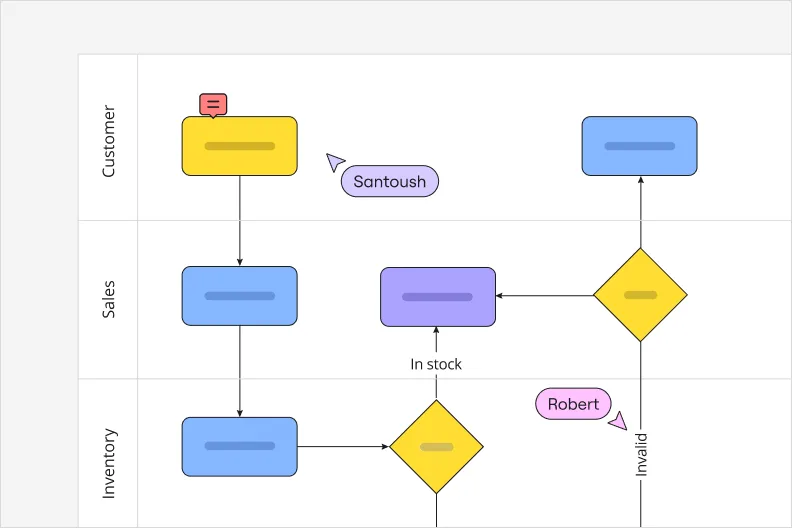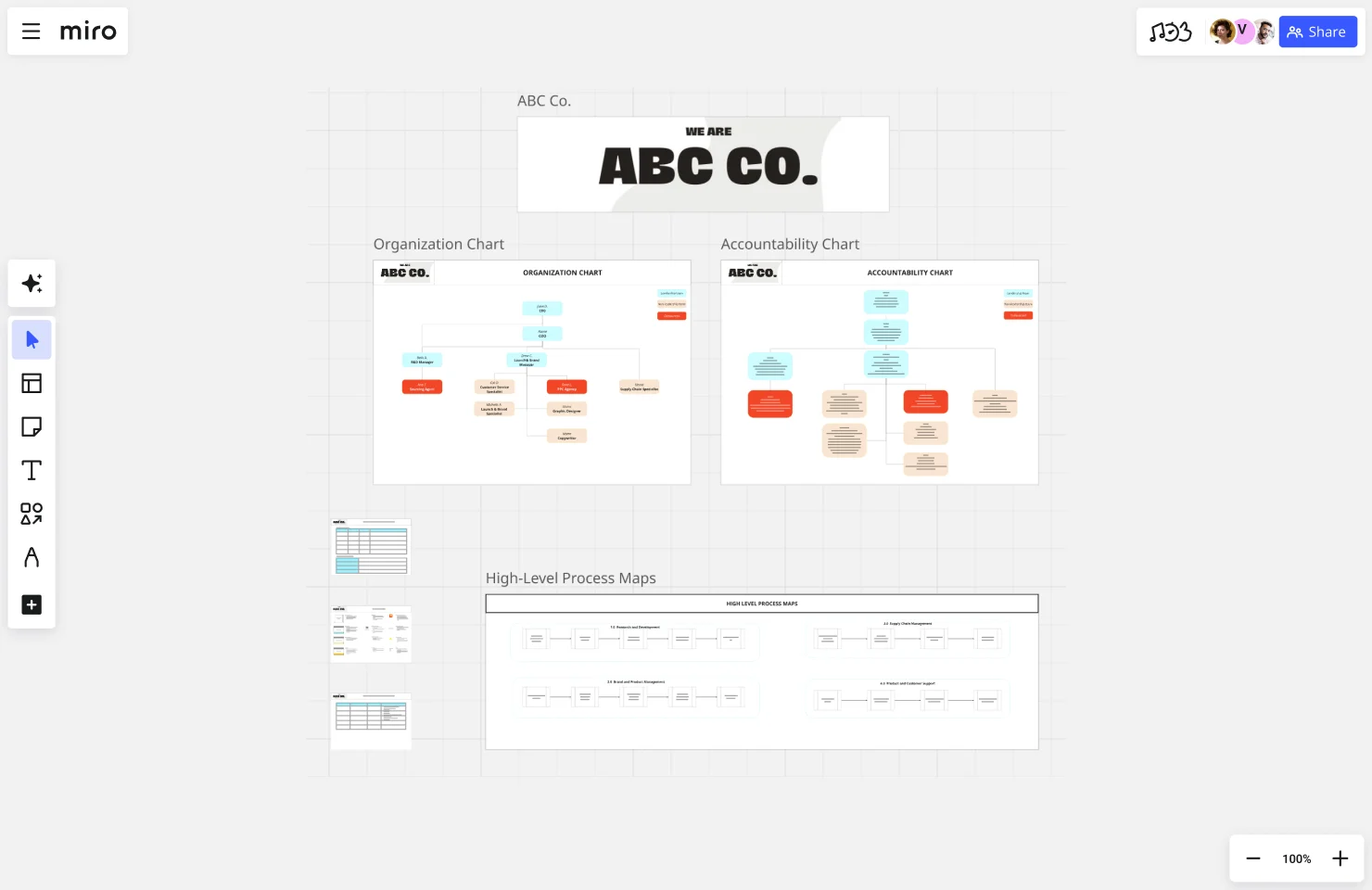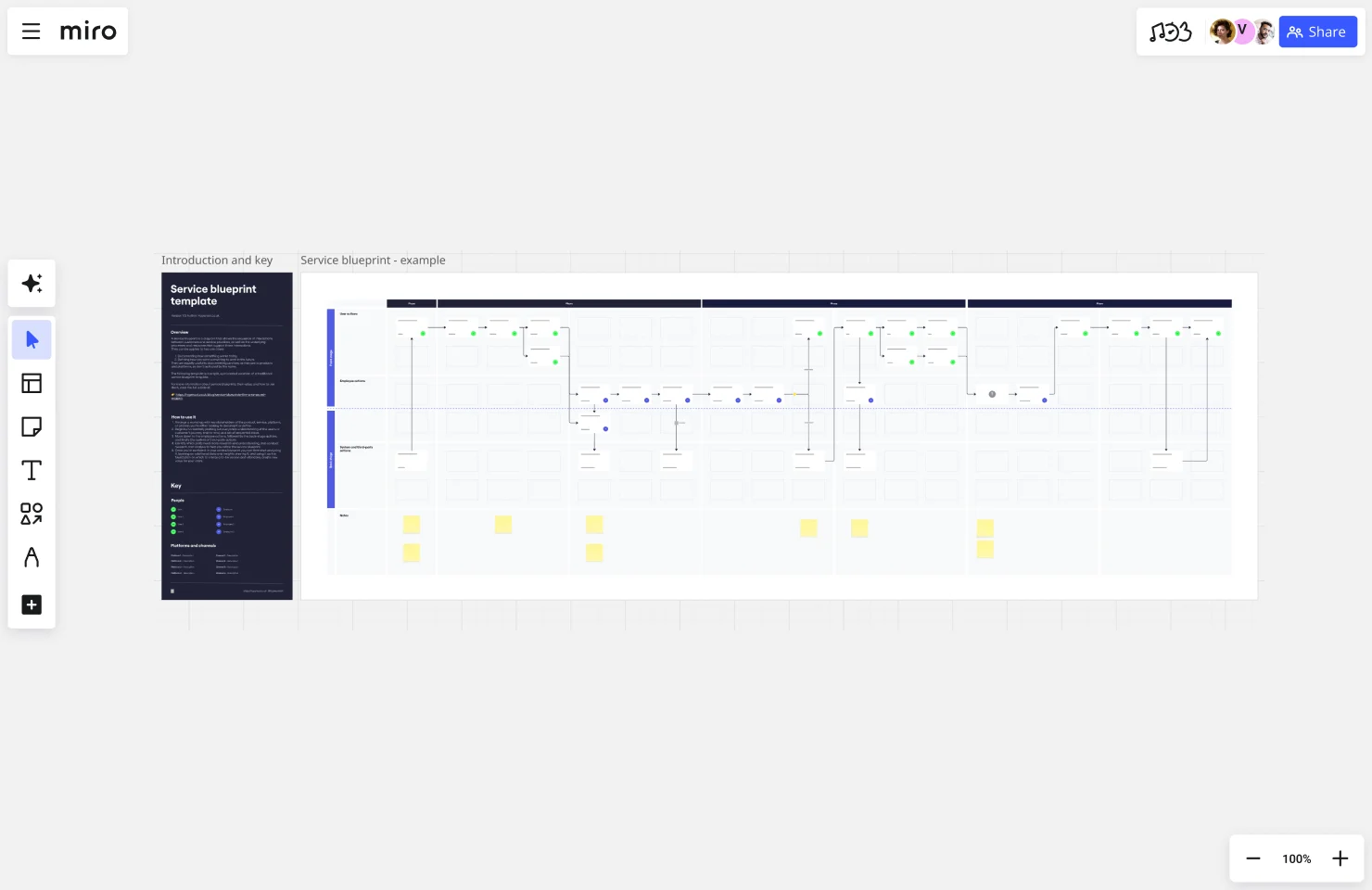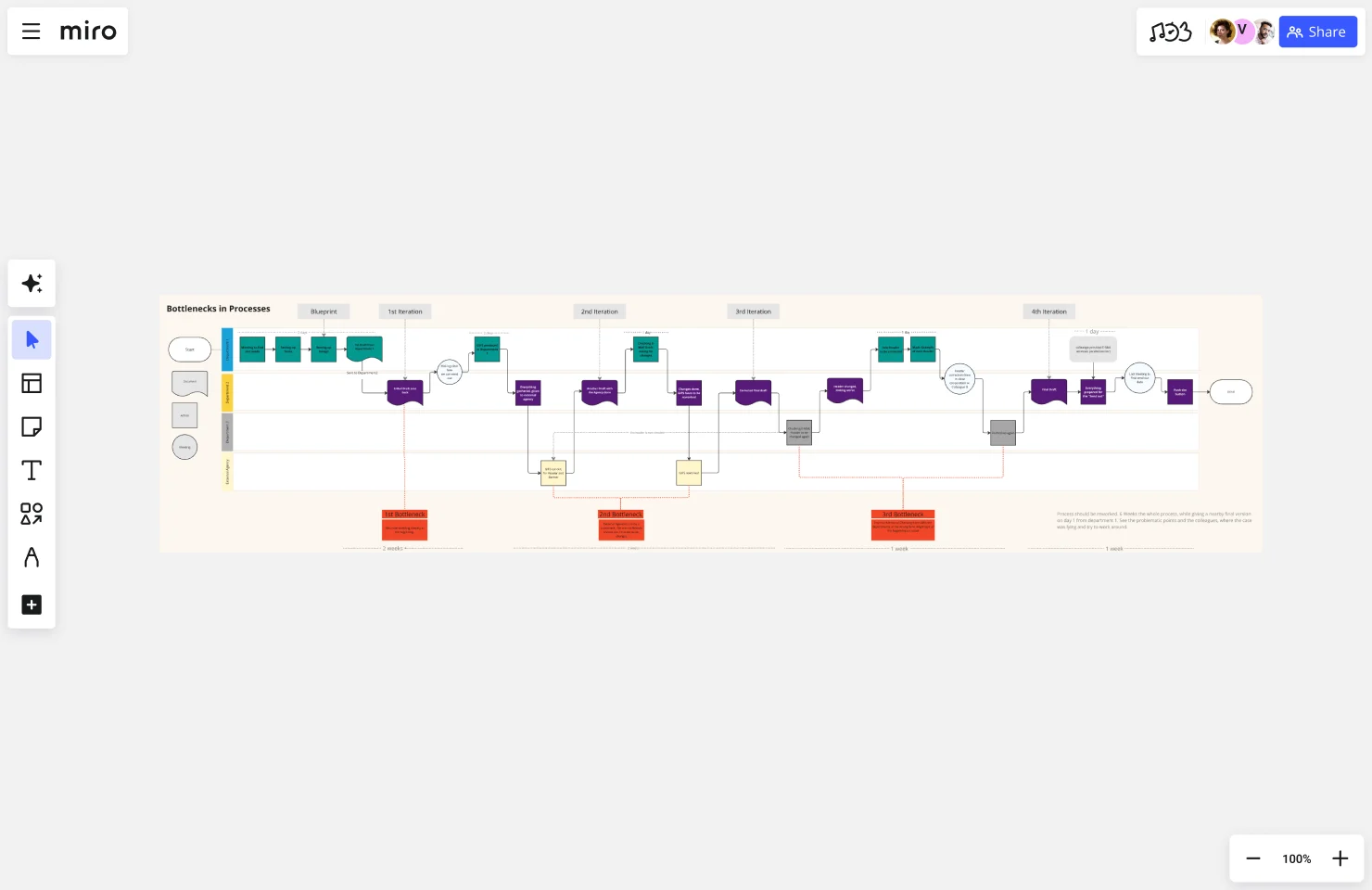
Recruitment process

Summary
In this guide, you will learn:
- Understand what streamlining processes means and why it matters for your team's productivity
- Learn the key benefits of process streamlining, from cost reduction to improved team collaboration
- Discover common inefficiencies that slow teams down, including redundant tasks and communication gaps
- Follow a step-by-step guide to streamline your workflows, from mapping current processes to measuring results
- Explore practical examples of streamlined processes across marketing, product development, and customer support
- Get actionable tips for successful implementation, including starting small and leveraging the right tools
Try Miro now
Join thousands of teams using Miro to do their best work yet.
How to streamline processes to make your org more efficient
If you calculated the cost of lost business, customer churn, and wasted employee time from inefficient processes, what would you find?
Every time you add new staff or technology to your business, your processes and workflows evolve. I’ve seen first-hand how these micro-changes add steps and complexity to your work — until you’ve inadvertently created a monster of frustrating and expensive inefficiencies.
Whether or not you’ve gotten to that point, it’s probably time for you to review your workflows and streamline your processes.
What does streamlining mean?
Streamlining means simplifying a process by removing non-essential steps or barriers to momentum. The goal of streamlining is to improve organizational efficiency, productivity, and ultimately the KPIs that drive your business forward.
Benefits and challenges of streamlining workflows in your organization
Streamlining processes can be a massive undertaking. Here’s why it’s worth it.
Benefits of streamlining processes
1. Improved efficiency
Reducing unnecessary tasks leads to better efficiency and productivity. You can lower costs and staff time, increase your outputs, and improve the value you deliver to customers.
2. Higher employee morale
72% of employees believe that inefficient processes impact their job satisfaction. Poor processes leave them frustrated and cause them to spend more time on repetitive tasks instead of more strategic, fulfilling work.
3. Better position to innovate and scale
When you build a culture around streamlining and improving processes, you place your organization in a much better position to pivot, innovate, and scale according to market needs and disruptions like AI.
Challenges of streamlining processes
A study by Mantis Research and Formstack found that some companies lose up to $1.3 billion a year on inefficient processes. Here’s why overhauling your systems is so difficult — and why companies stick with inefficient processes for so long.
1. Pushing past the status quo
Changing one person’s habits is hard. Changing a whole company’s habits is even harder. That’s why there’s an entire field of research dedicated to change management in business. Change brings out insecurity, uncertainty, and fear in all of us. To learn new work patterns, it takes a cultural shift and internal champions who can drive change.
2. Lack of communication and collaboration
Different departments in the same company often feel like they’re competing for resources and have different priorities. Sound familiar? As a leader, you need to incentivize teams to collaborate by facilitating open dialogue.
How to streamline processes and workflows
Let’s take a look at three streamlining techniques with examples to understand how this might play out in your organization.
Use process mapping
A process map is a versatile tool that you can apply to any function within a company. Building a process map lets you establish effective and efficient project management by identifying the workflow goals, laying out the process steps, and finding potential improvements.
The best way to approach this is by laying out each step in a collaborative online workspace session that allows teams to capture an accurate level of detail while contributing ideas. By creating this process in a collaborative environment, you can set expectations to reduce future misunderstandings, as well as onboard new team members with ease.
Once finalized, your process map can be documented and referenced for projects or added to a workflow integration to automate steps.
Example: Organizational & Process Mapping by Stacey Fortuna
This Miroverse template from Escala’s Continuous Process Manager, Stacey Fortuna, provides a blueprint for a basic process map, which helps companies document their activities and chart their organizational structure.
To use it, first complete an organizational chart and an accountability chart to help teams understand their responsibilities. Next, use the frames to map out processes at both a high level and a more detailed view, so you can identify areas for improvement.

Improve hiring and onboarding
Hiring and onboarding are perfect examples of cross-departmental functions. You need leadership, a hiring manager, HR, legal, and IT to collaborate to approve a hire, recruit candidates, and onboard. When this process is broken, hiring becomes so slow and difficult that your top candidates will be gone before you can make an offer — already working for your competitor.
Example: Headcount approval process flowchart
This headcount approval flowchart from Ben Craig, Miro’s Head of Recruiting & Employer Brand, shows just how complex hiring can be and helps users create a workflow for each scenario. Start with this template to create a flowchart of who needs to be involved and what the steps are to approve a new role. You can visualize how processes differ in common situations; for instance, your external hiring process versus your internal process.

Create a service blueprint
“Customers are the main victims of inefficiency with poor service, long waiting times, and a generally frustrating experience. When internal processes are bad, customer satisfaction drops,” explains Lindenberg. To improve your processes for customers, you need a service blueprint.
Also known as a customer journey map, a service blueprint shows the end-to-end journey of how a business delivers its product or service from the customer’s perspective. To draw one, create a flowchart showing each step and interaction a customer takes to receive a product or service.
Now, identify potential points of customer frustration or abandonment with user research and look for ways to deliver faster or better service at those friction points.
Example: Service blueprint by Hyperact
This simple service blueprint lets you map out how your current service blueprint works or plan a new one. To make it more valuable, you can diagram the underlying processes and resources that support those interactions, like employee actions or automations.

5 steps to streamlining processes in your organization
If you feel like your processes are broken, don’t lose hope! Follow these five steps to identify your main issues and create solutions in your workflows.
1. Engage stakeholders first and throughout the process
If you don’t invite important stakeholders to the table, all you’ll have at the end of this exercise is a pretty flow chart. You won’t enact any change because you won’t have buy-in.
“Stakeholders should be involved through clear visualizations on a board, not just in meetings with vague explanations,” says Andreas Lindenberg, UX CSAT specialist for MISUMI Europa. “You need a concrete, logically clear step-by-step visualization. Done well, it removes room for misunderstandings between teams.”
Stakeholders can be leaders and field-level personnel who can explain how they do their jobs and flag any early issues with proposed adjustments.
In distributed teams, you face the additional challenge of engaging stakeholders virtually. “The biggest challenge of streamlining processes, in my belief, is that people are disengaged,” says Daria Rudnik, a business coach, consultant, and lecturer in HR and leadership.
“The first thing to do is to create this feeling of trust and collaboration at the start of the workshop, or even before the workshop so that people can feel comfortable sharing what they think.”
2. Audit your current processes
The biggest reason companies have duplicate or inefficient tasks is because there is no documented process. Workflows are either built on assumptions, or their documentation is so outdated that it is no longer relevant.
“When processes aren’t clear, employees may have difficulty seeing the big picture or recognizing how their individual tasks contribute to the overall goals,” says Lindenberg. “Many undocumented workarounds create invisible and unknown obstacles and slow down or even stop progress and improvements.”
Start by documenting how the current process works or find the last known documentation (or both!). Use an online workspace for innovation like Miro to map out your processes visually. Have teams work on this in small groups and compare the results to see where gaps and mismatched expectations exist.
3. Identify bottlenecks and friction points
Next, ask your teams to identify friction points that are causing a process to take longer or be less efficient. These could be:
- Multiple approvals that cause delays
- Supply shortages or missing resources
- Work that needs to be redone because of mismatched expectations
Once you know these friction points, your team can start brainstorming solutions. If they’re stuck, try asking them to reimagine multiple ways to rework the process, starting with a “what if we…?”
4. Visualize your improved processes and workflows
Just as you started by documenting your old process, use visualization to brainstorm, iterate, and finalize your new and improved process. Whether you make small changes or completely reinvent your process, visualization gives you a source of truth that’s accessible and easy to understand.
Even remote teams can take advantage of tools to facilitate visual collaboration. Use a virtual board like Miro where you can easily diagram with shapes, arrows, and color coding to document relationships between actions and people.
“By enabling users to visualize processes comprehensively, share and store insights, Miro not only addresses but effectively helps teams overcome barriers to process optimization,” says Lindenberg.
5. Align roles with tasks and responsibilities
Auditing your organizational processes may lead to a lightbulb moment when you realize you need to reshuffle responsibilities within or across teams, and that’s a good thing.
At the end of the day, streamlining processes with a visual tool gives you a roadmap to clarity for everyone who carries out the work. Ultimately, this will equip every team member with purpose and buy-in to do their best work.
Take this final Miro template, which helps you align processes with responsible parties and break out from silos that keep your company from reaching its goals. You can use this in a workshop to create a basic org chart, map interactions, and give names and language to your silos, barriers, and bottlenecks.

Tap into the power of streamlining for operational excellence
Streamlining doesn’t just make a better experience for your customers and employees — it unleashes your growth potential. When you can visualize your processes, collaborate across silos, and deliver faster, better solutions, the sky’s the limit.
Author: Mandy Bray, Contributing Writer
Last update: December 16, 2025